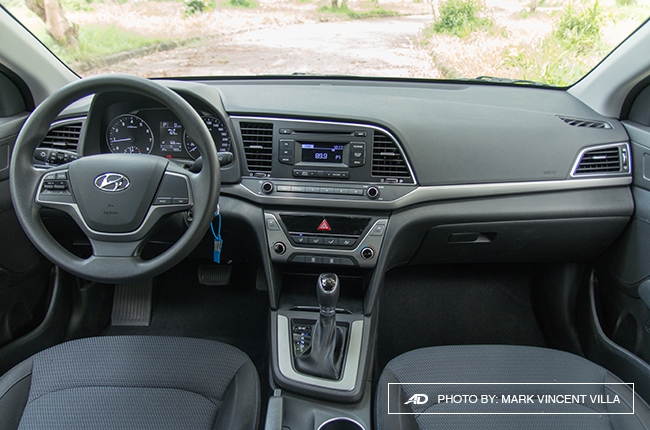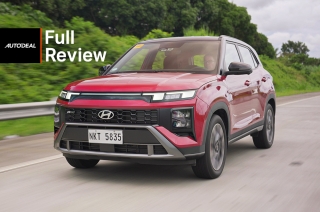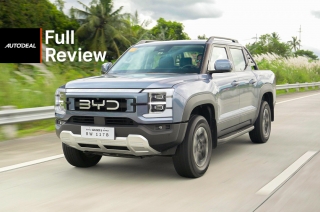
Compact sedans has been one of the popular vehicles in the local market. Today, more Filipinos prefer to buy SUVs, MPVs, crossovers, and even pickups. This phenomenon could be attributed to the compact sedan’s price tag, which is almost on the same ground with the other mentioned type of vehicles. You can also take into account that SUVs and MPVs can accommodate up to 7 occupants, a huge plus point considering that Filipinos love to travel in groups.
In AutoDeal, the top 3 vehicles for April 2017 are composed of an MPV, SUV, and crossover. Despite of this telltale signs, manufacturers are still pitting their respective challengers in the compact sedan segment.
To deliver that point and to see whether it can bring back the popularity of compact sedans, Hyundai handed over the keys of the 2017 Hyundai Elantra 1.6 GL, the mid-variant model. So, let’s see how it plays out.
You have to thank Hyundai Motor Group’s president and chief design officer Peter Schreyer if you love the new exterior styling of the Elantra. Schreyer is credited to Hyundai’s new look, which they call the Fluidic Sculpture. Before joining the Korean brand, he worked for Audi and known for his designs on the A3, A4, and A6.
Visually, the 2017 Elantra has an angular body with the reduction of curves and flowing lines. It is fitted with a hexagonal grille, sharp-looking headlights, and a large bumper – giving the vehicle a confident stance. Towards its side, straight lines characterize the Elantra while the wheel arches are now less prominent as compared to the outgoing model.
Engine Output (HP), Acceleration, Transmission, Handling 3.5/5
Exterior & Interior Design, Quality, Fit and Finish, Ergonomics 3.5/5
Cabin Comfort, Suspension, NVH Insulation 3.5/5
Convenience Technologies, Active and Passive Safety Features 3.0/5
Amount of the vehicle you get for the price, Fuel Efficiency 3.0/5
- Better exterior design as compared to its predecessor.
- Stable ride.
- Driver-oriented dashboard.
- Doesn't have a Bluetooth function.
- No one-touch power windows up or down for the driver.
- For its price, it could have been integrated with more safety and tech features.

As a whole, the exterior allows the vehicle to have a more mature look without compromising its youthful vibe. We actually prefer the Elantra’s new angular body than its flowy and curvy design before because it’s more subtle but still has the qualities to get your attention. The only thing we think that Hyundai should have considered was to make the Elantra more sporty – similar to other vehicles in its class. It’s like a halo-halo, complete with all the sahogs, but lacks sugar. Not a good idea to use halo-halo as an analogy; we now have to resist our cravings for that cold dessert.

Inside the cabin, the Elantra has a straightforward design along with a driver-oriented layout. The latter gives the driver the liberty to not lean forward in order to reach the controls. Speaking of which, the controls are organized in such a way that one wouldn’t be overwhelmed or confused. In other words, they are well-placed. Hard plastic materials somewhat dominates the entire cabin, but this is tolerable considering the neat layout of the dashboard.

This particular variant comes with fabric seats and audio system that features a CD, MP3, Aux, and USB compatibility. However, this Elantra doesn’t have a Bluetooth function. It also doesn’t come with speed-sensing door locks and rear backing sensors, as well as one-touch power windows up or down for the driver. On the other hand, these things are made up for with the Elantra’s spacious interior. The rear leg- and head-room is decent, giving passengers a comfortable ride. You can let 3 of your healthy 5’5’’ friends sit at the back without a problem.
This mid-variant Elantra is powered by a 1.6L gasoline engine. It produces 128 hp and 154 Nm of torque while shifting is via 6-speed automatic transmission. With its power output ratings, the Elantra is at par with its rivals.

The Elantra can tackle the congested city roads with ease. Your arms wouldn’t be subjected to a lot of work thanks to its electronic power steering wheel. It feels light, which gives you a relaxed feel behind the wheel. The weak points we mentioned in the Elantra’s interior is further compensated by its good ride comfort. It absorbs road impact well and it doesn’t lose its composure when faced with Metro Manila’s potholes and dilapidated roads. The Elantra also has a nice cabin acoustics with road and engine noise reduced to a minimum. In terms of fuel economy, the vehicle registered 7 km/l with an average speed of 15 km/h (moderate to heavy traffic).
Out on the open highway, the Elantra is stable and planted, which gives you confidence when changing lanes. It delivers enough power with relatively minimum lag, allowing you to overtake slower vehicles with good measure. Moreover, the engine is never short of climbing power when tackling uphill roads and it is doesn’t lose its poise going downhill. Fuel economy-wise, this Elantra yielded 18 km/l while running at an average speed of 85 km/h.

Overall, this mid-variant Elantra could bring back the popularity of compact sedans in the local market but, there’s one issue that needs to be addressed – its price tag. At P1,008,000, this Elantra could have a tough time winning the hearts of those who prefer SUVs and MPVs that are priced relatively on the same ground. However, the Elantra’s new exterior look, roomy cabin, and stable ride could just be enough to make a change of heart.
Latest Review
-
2026 BYD eMAX 7 Review / Review
Can the BYD eMAX 7 prove that electric MPVs work in the Philippines? With 201 hp and 530 km of range, it just might.
4.3 / 5 -
2026 Hyundai Creta N-Line Review / Review
The Creta N-Line isn’t just a Creta with sporty looks; it’s got the performance and bite to back up its style.
4.3 / 5 -
2026 BYD Shark 6 DMO Review / Review
Can a hybrid pickup truck break the mold of what pickup trucks can be? The Shark 6 DMO has something to say about that.
4.6 / 5
Popular Articles
-
Electric Vehicles in the Philippines for under P1 million
Jerome Tresvalles · Aug 19, 2025
-
Top 3 Cars For Every Lifestyle—What Cars Are Right For You? | Behind a Desk
Caco Tirona · Apr 24, 2024
-
5 Tips to Maximize Fuel Efficiency
Jerome Tresvalles · Sep 09, 2024
-
Five driving habits that are draining your fuel tank
Jerome Tresvalles · Jun 24, 2025
-
Can engine braking harm your engine?
Jerome Tresvalles · Sep 11, 2025
-
Do electric cars even need maintenance?
Jerome Tresvalles · Oct 23, 2024
-
Best vehicles for an active outdoor lifestyle
Shaynah Miranda · Jul 25, 2024
-
How to drive different types of vehicle transmissions
May 23, 2024
-
5 easy ways to keep your car interior clean
Allysa Mae Zulueta · Nov 15, 2021
-
How to survive Metro Manila traffic
Earl Lee · Aug 16, 2022



